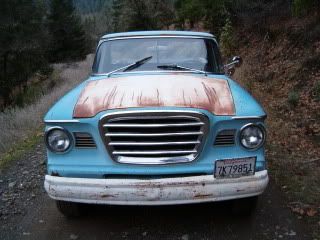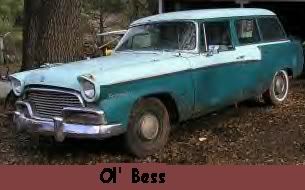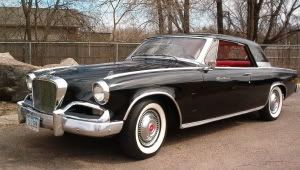While preping my 1964 Cruiser, which has the 289 eng. for the hot summer, I was wondering if any new products or improved methods of handling this problem have been tried. I currently have a 3/16" return line, taking off at my carb. This seems to work ok, yet I would like to think something else someone has tried may work better. Thanks
Announcement
Collapse
No announcement yet.
Vapor Lock anything new ?
Collapse
X
-
There are a couple of solutions to vapour lock in your Cruiser. First, is there a clamp securing the fuel line at the top of the engine? if so, either wrap the fuel line so that the clamp doesn't make contact, or remove it. My experiance is that the clamp will transmit heat into the fuel line. Another solution is to put clothes pins on the fuel line from the pump up to the top of the motor. This insulates the line and keeps it from touching the motor. Another method that looks a bit better, is to get a piece of rubber hose that's large enough for the fuel line to easily slip into. Slip this over the metal fuel line all the way down to the pump and it will insulate the line from the heat of the motor (and look much better than thirty or forty clothes-pins).


Home of the famous Mr. Ed!
Lotsa Larks!
K.I.S.S. Keep It Simple Studebaker!
Ron Smith
Where the heck is Lewiston, CA?Home of the famous Mr. Ed!
K.I.S.S. Keep It Simple Studebaker!
Ron Smith
Where the heck is Fawn Lodge, CA?
-
When you fill up your gas tank, add ONE gallon of diesel fuel to a fillup. Works great and doesn't affect performance!
Works great and doesn't affect performance!
Miscreant adrift in
the BerStuda Triangle

1957 Transtar 1/2ton
1960 Larkvertible V8
1958 Provincial wagon
1953 Commander coupe
No deceptive flags to prove I'm patriotic - no biblical BS to impress - just ME and Studebakers - as it should be.
Comment
-
Thanks for the info, never tried the diesel,may give it a shot I have read about it. My neighbor made a small heat shield. We removed the rear most fuel pump mount bolt installed a long stud with lock washer and nut installed the shield with a wing nut. He put heat resistant tape on one side. Whole thing about 3x6 inchs.
Comment
-
The diesel trick works good! No smoke.
I worked at an airport operation for a time. One of the line loonies filled his Charger's tank with JP4 jet fuel one nite. Afterwards, he came to me for answers. Seems he couldn't understand why the car had quit running in short order and wouldn't restart again![xx(]
Miscreant adrift in
the BerStuda Triangle

1957 Transtar 1/2ton
1960 Larkvertible V8
1958 Provincial wagon
1953 Commander coupe
No deceptive flags to prove I'm patriotic - no biblical BS to impress - just ME and Studebakers - as it should be.
Comment
-
Diesel fuel??? Why Diesel fuel? If you would be so kind, please explain to this dummie, what that's supposed to do for vapor lock.quote:Originally posted by Mr.Biggs
When you fill up your gas tank, add ONE gallon of diesel fuel to a fillup. Works great and doesn't affect performance!
Works great and doesn't affect performance!
T'anks,
Karl

1962 GT Hawk 4sp
Comment
-
Vapor lock is when the fuel vaporizes while still in the fuel line ahead of the carb. When the fuel pump tries to push fuel through the line, all it does is compress the vapor which then expands back to it's former size on the pump's down stroke. Not that much different from having air trapped in the brake lines. Stomp on the brake and the moving liquid from the master cylinder merely compresses the air bubble instead of pushing brake cylinder outward.
Most likely the diesel raises the temperature required for the fuel to vaporize. Let gasoline set out and it evaporates away but diesel sets there seemingly forever. Don't want to put too much in though because vaporization is what keeps the gasoline atomized in the fuel air charge. If it doesn't vaporize the stuff lays in the intake manifold as a liquid....exactly what happens when your car gets flooded on gasoline.
Comment
-
Don't know much about it, except that I never experienced it until filling up with that bargain 87 octane gas in Omaha. At first I didn't know what the heck was happening, but things got dramatically better as I travelled further west.

Steve Hudson
The Dalles, Oregon
1937 Dictator Streetrod
1949 "GMOBaker" 1-T Dually
1953 Commander Convertible
1954 Champion Coupe
Steve Hudson
The Dalles, Oregon
1949 \"GMOBaker\" 1-T Dually (workhorse)
1953 Commander Convertible (show & go)
1953 "Studacudallac" (project)
Comment
-
I don't know how far west you went Steve, but as the altitude increased, atmospheric pressure went down which effectively reduced the compression ratio and richened the fuel air mixture. Less compression and more fuel cools the combustion temperature which means less engine heat, less heat reduces the chances of the fuel vaporizing in the line. In addition, as the humidity goes down traveling west, the drier air is more effective at conducting heat away from the radiator. My air cooled bike always got better mileage and ran quieter out west than out east. Of course there was less power at higher altitudes. Lower humidity also improved fuel mileage. Humid air contains moisture that not only displaces air but requires heat to be converted into a gas. Unfortunately, the benefit of the expanding gas doesn't equal the amount of energy required to turn it into steam.
Comment
-
Don't mean to hi-jack the thread, but I gotta ask this question. So is what you said above the main reason why my newer fuel-injected V8's get so much better fuel mileage west of Nebraska and Kansas, than they do here in the Midwest?quote:Originally posted by John Kirchhoff
I don't know how far west you went Steve, but as the altitude increased, atmospheric pressure went down which effectively reduced the compression ratio and richened the fuel air mixture. Less compression and more fuel cools the combustion temperature which means less engine heat, less heat reduces the chances of the fuel vaporizing in the line. In addition, as the humidity goes down traveling west, the drier air is more effective at conducting heat away from the radiator. My air cooled bike always got better mileage and ran quieter out west than out east. Of course there was less power at higher altitudes. Lower humidity also improved fuel mileage. Humid air contains moisture that not only displaces air but requires heat to be converted into a gas. Unfortunately, the benefit of the expanding gas doesn't equal the amount of energy required to turn it into steam.
Simply because the air is "thinner" and "less humidity"? Amazing, the stuff I learn here on this forum!
Ok, I now return y'all to your regularly scheduled programming.

1962 GT Hawk 4sp
Comment
-
My '51 has an asbestos hose that surrounds the fuel line where it arcs over the exhaust manifold. I guess most of those have disappeared over the years. Never had a vapor lock.
Brad Johnson
Pine Grove Mills, Pa.
 '33 Rockne 10, '51 Commander Starlight, '53 Commander Starlight
Brad Johnson,
'33 Rockne 10, '51 Commander Starlight, '53 Commander Starlight
Brad Johnson,
SDC since 1975, ASC since 1990
Pine Grove Mills, Pa.
'33 Rockne 10, '51 Commander Starlight. '53 Commander Starlight
'56 Sky Hawk in process
Comment
-
The nice thing about fuel injection is that it takes into account atmospheric pressure when metering fuel. Your engine will produce less horsepower at higher altitudes, but at least it won't richen up the mixture like a regular carb would. I had to carry smaller main jets for a Honda I had which was a pain to change on the road.
I believe water expands something like 1000 times its volume when it turns into a gas which you'd think would give an engine a little extra get up and go, but actually all it does is soak up heat which would normally be producing power. When it comes to losing engine heat, ask any biker with an air cooled bike about what happens when you're in all day rain. You can be getting 40 mpg but along comes rain, cools off the engine and your mileage drops to 30-35. Heat is power for the engine to produce the same amount of power, it requires more fuel-air be introduced to compensate for heat losses elsewhere.
Incidently, when it comes to a turbocharger producing more power, nothing in this world is free. The required to turn the turbo is extracted from the exhaust heat. Normally about 35% of the energy in a gallon of fuel is lost or wasted in the form of exhaust heat with a naturally aspriated engine. Slap on a turbo, and you reduce that loss to around 30%. With gasoline, that 5% is equal to around 5,700 btu's, which represents the amount of energy used to turn the turbo.
Other heat losses on engines are about 5% through oil and 30% through the cooling system as an average. Anyone that's ever been in a chilly wind with a wet shirt knows how much more effecient water is at conducting heat than is air, so it's pretty obvious why my bike's gas mileage drops like a rock when Mother Nature starts throwing cold water on my parade.
Comment
-
There was a topic on the diesel solution in the last 12 months. Somebody explained that modern petrol was more highly refined these days, creating fuel with lower vapour or boiling point, or something like that. The diesel fuel appaerently has a higher vapour or boiling point. The explanation had something to do with simple and complex molecules.
/H
Comment
-
Actually ethanol tends to be the culprit in raising the vapor point of gasolines. The higher the vapor pressure, the more volatile it is at the same temperature and the more likely it is to vapor lock. A 10% ethanol blend raises the vapor pressure something like 5-15% depending upon whether the gasoline is a winter (higher vapor pressure) or summer (lower vapor pressure) blend. Ethanol is often used as an oxygenator anymore after MTBE fell out of favor because of it's eagerness to find it's way into drinking water supplies. One thing that'll cause big problems is to buy a bunch of winter blend gas and not use it until summer.
Comment
Comment